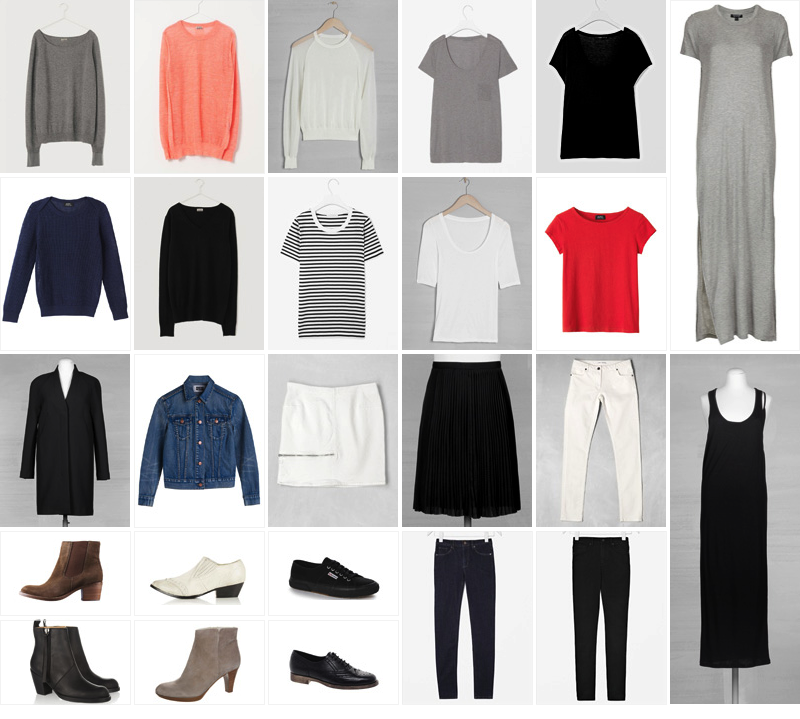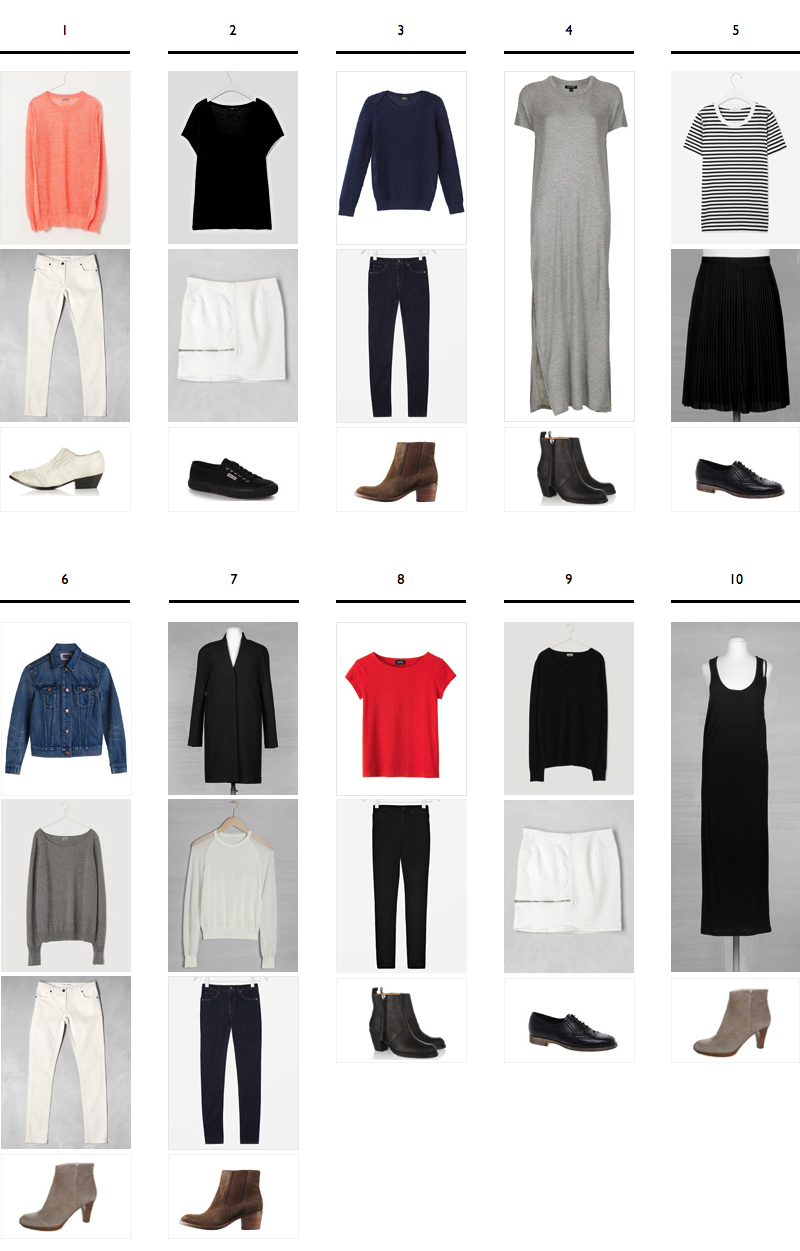Building a Capsule Wardrobe from Scratch: An Example
 Let's talk about capsule wardrobes!
Let's talk about capsule wardrobes!
First, a quick recap: The idea of building a capsule wardrobe is to curate a small selection of items that form the backbone of your wardrobe. Ideally it should consist of about 20 to 30 key pieces and basics that are tailored to your lifestyle and express the essence of your personal style. If you are new to the concept of capsule wardrobes, read my Building a Capsule Wardrobe 101 post for a detailed description and a step-by-step guide for creating your own. These are the four steps I describe in the post:
- Step 1: Create a concept
- Step 2: Build a basic structure
- Step 3: Use your concept to concept to fill the structure with specific items
- Step 4: Implement your wardrobe and test-drive outfits
To illustrate the process a bit more and also show you what a complete capsule wardrobe could look like, in this post we will be creating an entire 25-piece capsule wardrobe for Marie, who sent me this email a couple of weeks ago:
"I am really into the idea of building a capsule wardrobe but I have trouble deciding on the right quantities and finding a good distribution of neutral and bright colors. I have a similar style to yours (quite classic and minimalist) and I want a wardrobe based on a monochrome color scheme and a few brighter colors (I like orange and red). My main spring uniform is a combination of skinny jeans, mid-heel ankle boots and a lightweight knit sweater. The second uniform (which I plan to wear slightly less often) is some kind of mini skirt, a simple t-shirt and flats. I also like maxi dresses and would probably wear them with ankle boots as well. I live in France where the weather is ok during the spring, so I won't need to wear a jacket or coat that often. How many items do you think I need for each category?"
Essentially, the info Marie has given us represents the first of the four steps of the Building a Capsule Wardrobe 101 process: a concept complete with a description of her style, preferred colour scheme, uniform and favourite proportions (=specific combinations of items). Step 1 = done.
Step 2: Build a basic structure
After you have defined your overarching concept the next step is translating this concept into a basic structure of categories and quantity estimates. This part can sometimes be quite tricky, because you have to convert an abstract, visual idea into something tangible. The easiest way to do this is to use your favourite proportions as a starting point. These are Marie's chosen proportions:
- Uniform 1: Skinny jeans + Mid-heel boots + Lightweight knit sweater
- Uniform 2: Mini skirt + Simple T-shirt + Flats
- Additional proportion: Maxi dress + Mid-heel boots
- Optional: Jacket/coat
From these proportions we can now derive a list of item categories and sketch out a basic wardrobe structure including quantity estimates. For example, Marie's capsule wardrobe could consist of these categories:
I chose the above quanitities by estimating the relative importance of each category based on Marie's email and aimed for a total of 25-pieces. I first started with outerwear: Since Marie won't always need to wear a jacket or a coat, one of each in versatile styles should be enough. The item categories for Marie's two uniforms should be allocated the majority of the available pieces: Since she wants to wear uniform 1 slightly more often than uniform 2, I assigned 3 items to the jeans category and 2 to the mini skirts category. She needs mid-heel ankle boots to wear with both the first uniform and the maxi dresses, so having at least 4 different pairs will give her a good range of options and her shoes a break between wears. Another aspect I considered are the laundry requirements of items: For example, t-shirts will need to be washed more often than knit sweaters, so I allocated 5 pieces to each category, even though Marie will be wearing her knits more often as part of her first uniform.
Step 3: Use your concept to concept to fill the structure with specific items
Now onto the third step: Use your style concept and colour scheme to fill in the structure of categories you just created. With Marie's style and favourite colours in mind, I did a bit of faux online shopping to scour out a sample set of items that could make up Marie's capsule wardrobe. Bear in mind that when you are creating a capsule wardrobe for yourself you definitely do not have to buy an entire new set of clothes - depending on how well-edited your closet is you will be able to fill about 60-80% of your structure with existing items. The challenge of this step is finding the best distribution of colours and styles to express your personal style and maximise the versatility of your capsule wardrobe. Below you will find suggestions for each of the 25 pieces of Marie's capsule wardrobe.
Since she prefers a base of monochrome colours, each of the two top categories include one black, grey and white piece. For the remaining two I chose one bright colour (orange and red) and one additional neutral colour or pattern (navy and stripes). Since the jeans and skirts categories of Marie's capsule wardrobe are relatively small I picked exclusively neutral-coloured pieces so she can combine them with brighter tops and accessories. For outerwear I went for a classic denim jacket and a sleek straight-cut coat to have her set for a maximum range of occasions. Marie's capsule wardrobe is a good example of a modular wardrobe system: Although she plans to wear her flats mainly with skirts and her boots with jeans, the general structure and colour scheme of her wardrobe allow her to wear any top with any shoe and both trousers or skirts. Here is a closer look at each of the items (go to the bottom of the post to see a list of sources).
Step 4: Implement your wardrobe and test-drive outfits
The point of a capsule wardrobe is not to only have those 20-30 pieces in your closet, but rather to establish a strong foundation that can be supplemented with accessories and seasonal pieces. However, a well-chosen capsule wardrobe can indeed give you a ton of outfit options. Here are ten example outfits from Marie's capsule wardrobe:
 Note that this is not a blueprint for a standard capsule wardrobe and not a guide on 'wardrobe essentials'. I believe that your capsule wardrobe should be closely tailored to your individual personal style and aesthetic ideas and therefore shouldn't be copied. Instead, take your time to analyse your lifestyle and preferences and develop your own personal list of wardrobe essentials. I hope this post could give you a few pointers.
Note that this is not a blueprint for a standard capsule wardrobe and not a guide on 'wardrobe essentials'. I believe that your capsule wardrobe should be closely tailored to your individual personal style and aesthetic ideas and therefore shouldn't be copied. Instead, take your time to analyse your lifestyle and preferences and develop your own personal list of wardrobe essentials. I hope this post could give you a few pointers.
Do you have a capsule wardrobe or a set of must-have wardrobe essentials? Tell me in the comments!
Here's where you can find the above items: Knit sweaters: Peach, grey, black - Closed, navy - APC, white - &otherstories. T-shirts: Red - APC, white - &otherstories, grey, stripy, black - COS. Jeans: White - &otherstories, black, dark denim - COS. Skirts: Black, white - &otherstories. Outerwear: Denim - Weekday, black - &otherstories. Dresses: Grey - Topshop, Black - &otherstories. Boots: Black - Acne, Brown - APC, Light camel - Pier One, White - Topshop. Flats: Sneakers - Superga, Brogues - Asos
